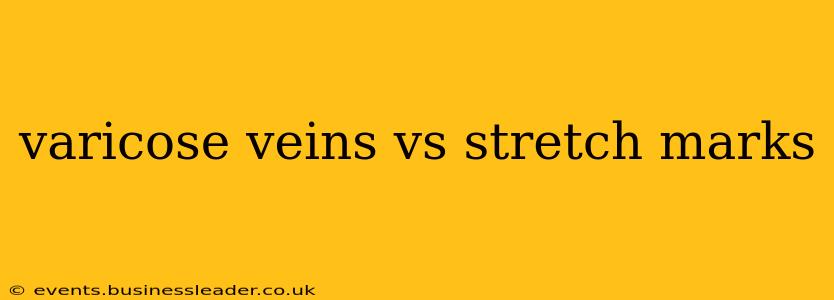Varicose veins and stretch marks are both common skin conditions, often visible on the surface of the skin. However, they are entirely different conditions with distinct causes, appearances, and treatments. This article will clarify the key differences between varicose veins and stretch marks, answering common questions many people have about these skin concerns.
What are Varicose Veins?
Varicose veins are enlarged, twisted veins that typically appear blue or purple and bulge beneath the skin's surface. They most commonly appear in the legs and feet due to the effects of gravity and increased pressure on the veins. The valves within the veins, responsible for preventing backflow of blood, weaken over time, causing blood to pool and the veins to swell.
Several factors contribute to the development of varicose veins, including:
- Genetics: A family history of varicose veins significantly increases your risk.
- Age: The risk increases with age as vein valves naturally weaken.
- Pregnancy: The increased blood volume during pregnancy puts extra pressure on the veins.
- Obesity: Excess weight adds further pressure on the veins.
- Prolonged standing or sitting: Limited movement restricts blood flow.
What are Stretch Marks?
Stretch marks, also known as striae, are streaks or lines that appear on the skin. They often have a silvery, white, or purplish hue and are caused by rapid stretching or tearing of the dermis, the middle layer of skin. This stretching can be triggered by several factors:
- Rapid weight gain or loss: Significant fluctuations in body weight can overstretch the skin.
- Pregnancy: The expanding abdomen during pregnancy puts considerable stress on the skin.
- Puberty: Rapid growth spurts during puberty can also cause stretch marks.
- Muscle growth: Significant increases in muscle mass, particularly through bodybuilding, can lead to stretch marks.
- Certain medical conditions: Some medical conditions like Cushing's syndrome can increase the risk.
How do Varicose Veins and Stretch Marks Differ in Appearance?
The visual differences are quite striking:
- Varicose veins: Bulging, raised, twisted veins, often blue or purple, usually appearing on the legs.
- Stretch Marks: Linear streaks or lines, often silvery, white, or purplish, appearing on various parts of the body (abdomen, thighs, breasts, etc.).
What are the Treatment Options for Varicose Veins?
Treatment for varicose veins depends on their severity and the individual's symptoms. Options include:
- Lifestyle changes: Weight management, regular exercise, and elevation of the legs can help alleviate symptoms.
- Compression stockings: These help improve blood circulation and reduce swelling.
- Sclerotherapy: This involves injecting a solution into the veins to close them off.
- Endovenous laser ablation (EVLA): This uses heat to close off the veins.
- Surgery: In severe cases, surgical removal of varicose veins may be necessary.
What are the Treatment Options for Stretch Marks?
Unfortunately, there's no way to completely eliminate stretch marks, but several treatments can help improve their appearance:
- Topical creams: Some creams containing retinoids, hyaluronic acid, or other ingredients may improve the appearance of stretch marks.
- Laser treatments: Laser therapy can stimulate collagen production, reducing the visibility of stretch marks.
- Microdermabrasion: This exfoliating treatment can help improve skin texture.
Are Varicose Veins and Stretch Marks Painful?
- Varicose veins: While not always painful, varicose veins can cause aching, throbbing, heaviness, swelling, and itching in the affected area.
- Stretch Marks: Stretch marks themselves are usually not painful, although the rapid skin stretching that causes them can sometimes be uncomfortable.
Can Varicose Veins and Stretch Marks Occur Together?
Yes, it's possible for someone to have both varicose veins and stretch marks. The conditions are unrelated, and their simultaneous presence is purely coincidental.
Can I Prevent Varicose Veins and Stretch Marks?
While complete prevention is not always possible, you can reduce your risk:
- Varicose veins: Maintain a healthy weight, exercise regularly, avoid prolonged standing or sitting, and wear compression stockings if necessary.
- Stretch Marks: Maintain a healthy weight, hydrate adequately, and manage weight changes gradually.
This information should not be considered medical advice. Always consult with a healthcare professional for diagnosis and treatment of any skin conditions.
